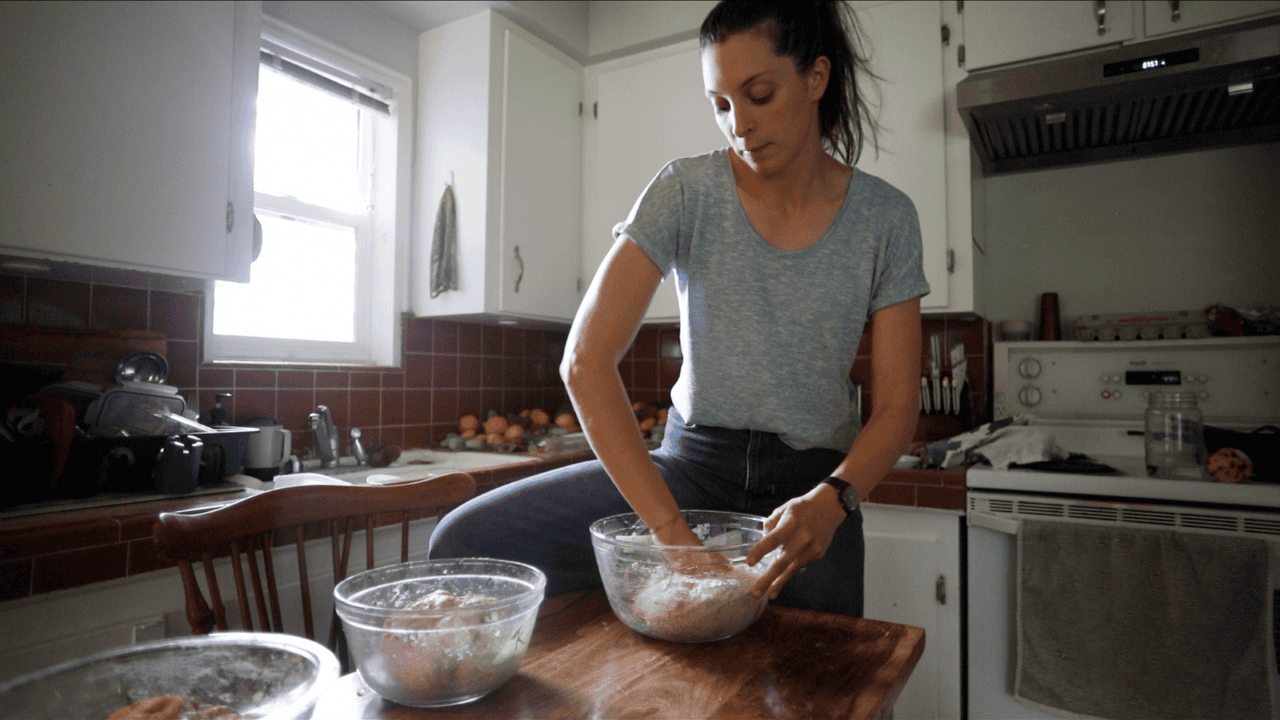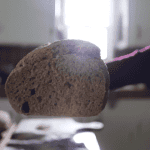Sourdough Recipe Whole Wheat Bread(Fresh Milled)
A sourdough recipe whole wheat made – with only salt, water and sourdough. The ancient method of freshly milled flour had a great purpose – nutrition! I believe God made a grain kernel packed with the nutrients we need for life. Eating baked goods (and bread in this case) with entirely fresh milled grains is how our ancestors fed themselves and remained healthy.
That’s why freshly milled whole grains are making a comeback – and rightfully so! So, let’s combine it with the ancient yeast – sourdough.
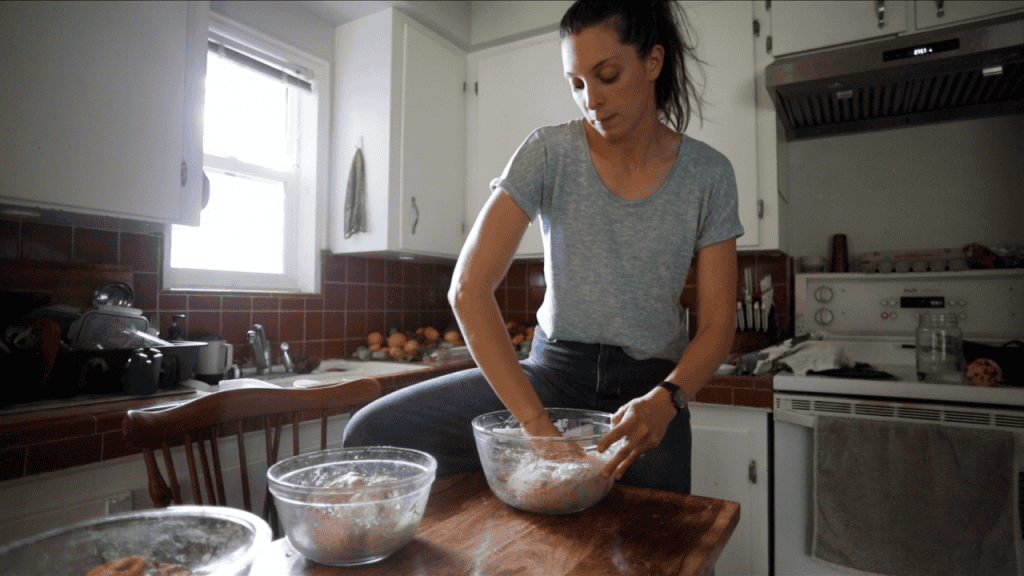
Directions for Sourdough Recipe Whole Wheat Bread
If you are new to baking with freshly milled whole grains, please red the entirety of this post before you make this recipe.
The simple overview for making this sourdough recipe with whole wheat is:
- Feed sourdough and wait 8-12 hrs
- Mill flour
- Mix & autolyse
- Finish mix
- Bulk fermentation
- Shape
- Score (optional)
- Bake
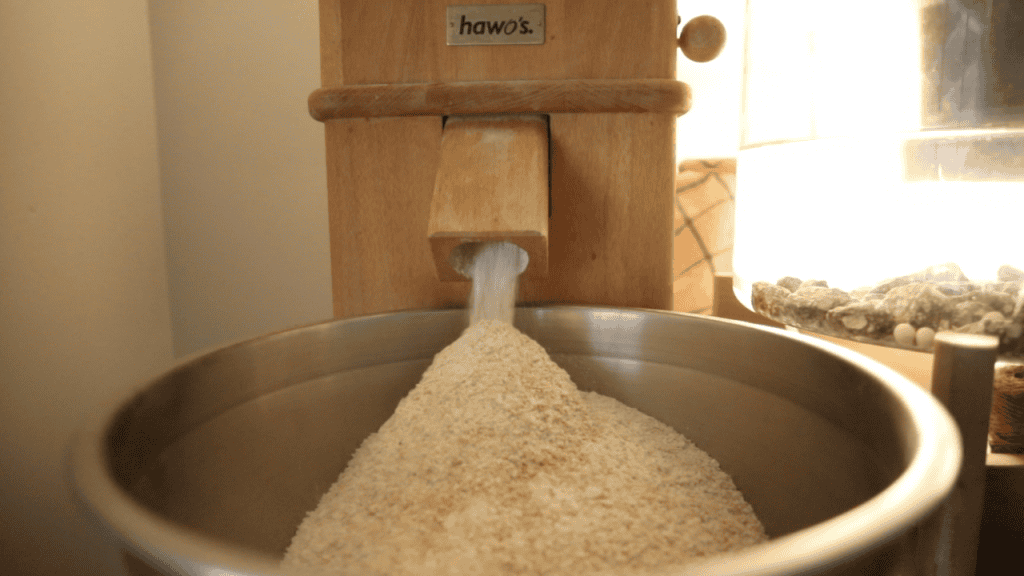
Feed Sourdough (with Fresh Milled Whole Wheat)
Just as with all sourdough, you want to start by feeding your sourdough starter. Take 1 tbsp of sourdough starter and feed it 1 cup of flour and a 3/4 cup of water.
I don’t mix 1 cup water to 1 cup of water, because I am trying to achieve a sourdough starter that is the same consistency as the dough is when I mix the bread. That way, when I add the sourdough starter to my bread mix, I’m not adding a lot of liquid, but more of a doughy texture to a dough. Because of the bread book that I learned from, I have just always kind of maintained that method.
Big question: Do you feed your sourdough starter with fresh milled whole wheat flour?
I said I would keep this simple, but you got to ask, do you feed your sourdough starter with whole wheat flour?
I say, yes. It makes sense to me that we want to be using whole wheat flour for all things in life. But I will say that you have to keep an eye on it.
As with all sourdough, it is a science and temperature matters and time matters. You have to look at what is happening and make decisions accordingly.
The rules with the sourdough starter is you want it to:
- double in size
- be bubbly
- have a sharp smell
And so you can feed it with freshly milled whole wheat flour, but just watch for when it has doubled in size, is bubbly, and has a fragrant smell.
You will notice, just like I did, that the window in which you can use your sourdough starter is much smaller. I do keep an elastic (or mark it with a piece of tape), and I check when it is, double in size.
Furthermore, don’t keep that sourdough starter outside of the fridge for too long, because based on what I’ve researched, the acidity in whole wheat flour can outrun your sourdough starter bacteria or whatever it is. And so it’ll just kind of kill it after some time.
Mill Grains
In another post, I’m going to explain in more detail the process of milling grains. If you have an automatic mill, just add your grains to the top and press the button to grind the flour.
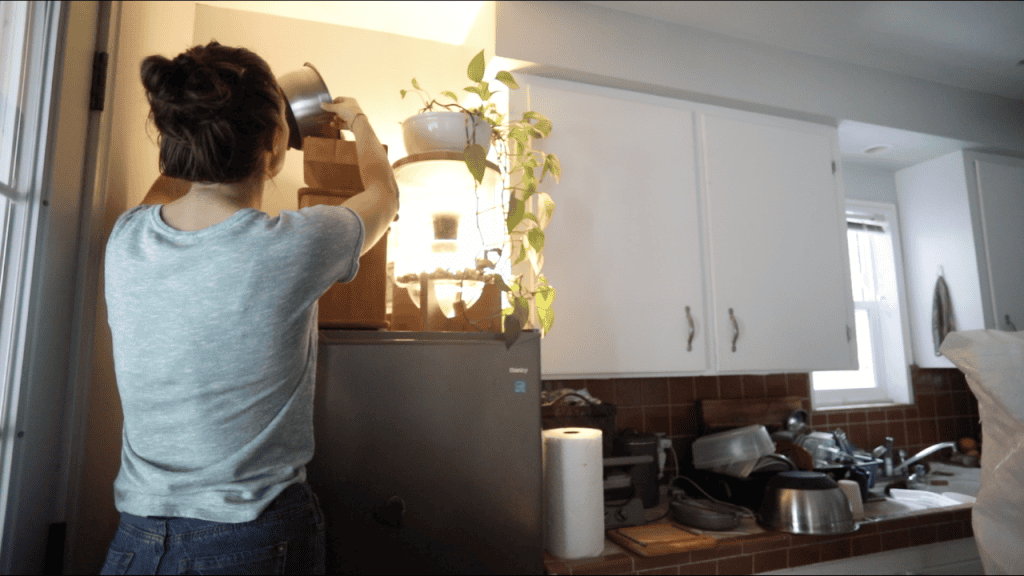
Mix, Autolyse & Finish Mix
Next, I mix the loaf. If you do end up making this bread, please would you leave it some reviews and give it a rating so that other people know that they can also trust this recipe.
I start by mixing flour and together, and letting it autolyse. That’s a scientific process where something happens between the flour and the water before I add the salt and the sourdough starter. I just learned to bake bread this way and so I always follow this process.
After about 20 minutes, I add in my sourdough starter and salt. Mix that together.
You will notice that it feels kind of odd at the beginning (or it just doesn’t feel the same as with white flour). There’s a stiffness in it and it doesn’t really mix all that easily. Don’t worry. Do an initial mix as best as you can. Leave it for five minutes and come back and you’ll see something happens with all these ingredients and it just starts mixing much easier.
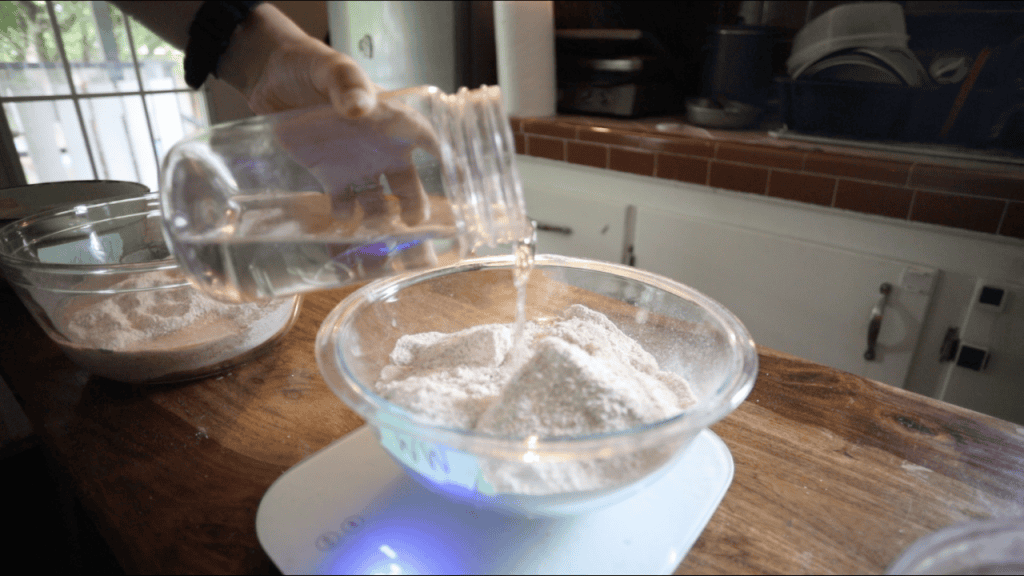
Bulk Ferment
Once you have finished your mixing, the bulk fermentation process begins. This is where the sourdough starter starts eating at those grains and fermenting it in a way where it is easily digestible for your body by the time you eat the bread. And so we want this process to happen. It’s really good.
The only thing that is problematic is that the freshly milled whole wheat flour seems to speeds things up in a way. Something happens with the chemistry, that I find it becomes overly moist and loses a lot of its structure really quickly.
The way to combat this is by doing my first four folds within about a 2 to 4 hour range and then shaping the loaves and getting them into the fridge to slow down the rest of the fermentation.
Since the ideal window to shape and bake the bread seems to be much shorter, I slow it down in the fridge to still get a nice rise when I bake the bread, rather than to miss the mark and then have flat bread or breads that turn out to be bricks.
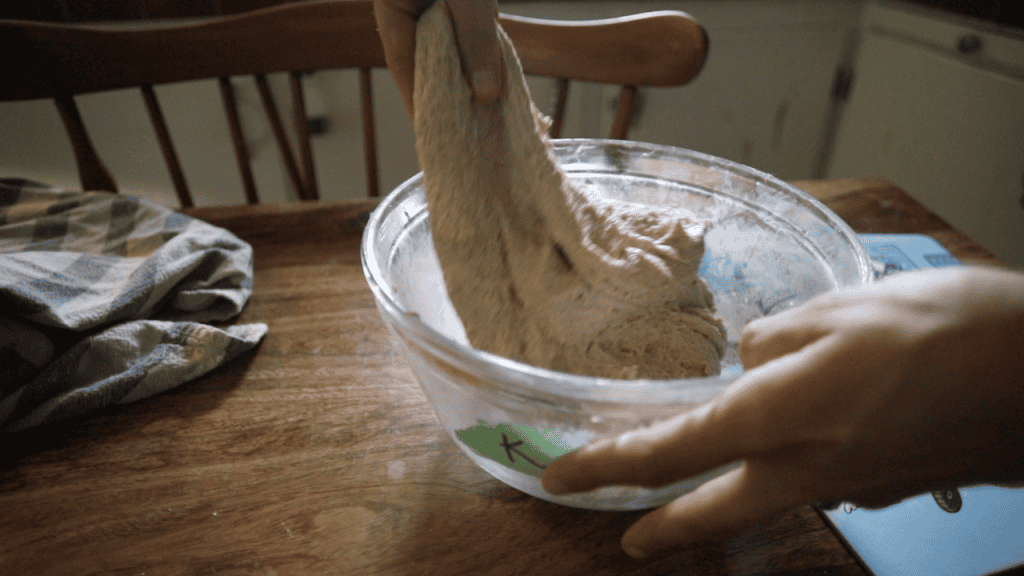
During this bulk fermentation, what you want to do is apply three to four fold to the dough. To fold, simply grab the edge of the dough, pulling it up as far as it’ll let you without tearing, and fold it over the dough. Do it until you’ve reached all the way around the dough. Sometimes four or five times to finish the circle. And then I let it rest for 20 30 minutes and then do it again. So let that happen over a 2 to 4 hour period.
Shape
Next I’m going to do a shaping of my loaves. I gently turn the dough onto a surface (with floured hands). Basically, what was the top is now going to be the bottom and the bottom is now going to be the top. It is on a lightly floured surface so that it doesn’t stick. Then I use my dough scraper to kind of pull the dough slightly outward and flat into a square format. The aim is to get it in a flatish square to fold in the sides and kind of roll the dough in on itself. I’m not very good at it yet, I’ll post a picture that I saw somewhere with the steps a little bit more clearly.
From: https://www.thefreshloaf.com/node/30405/shaping-sandwich-loaf-illustration
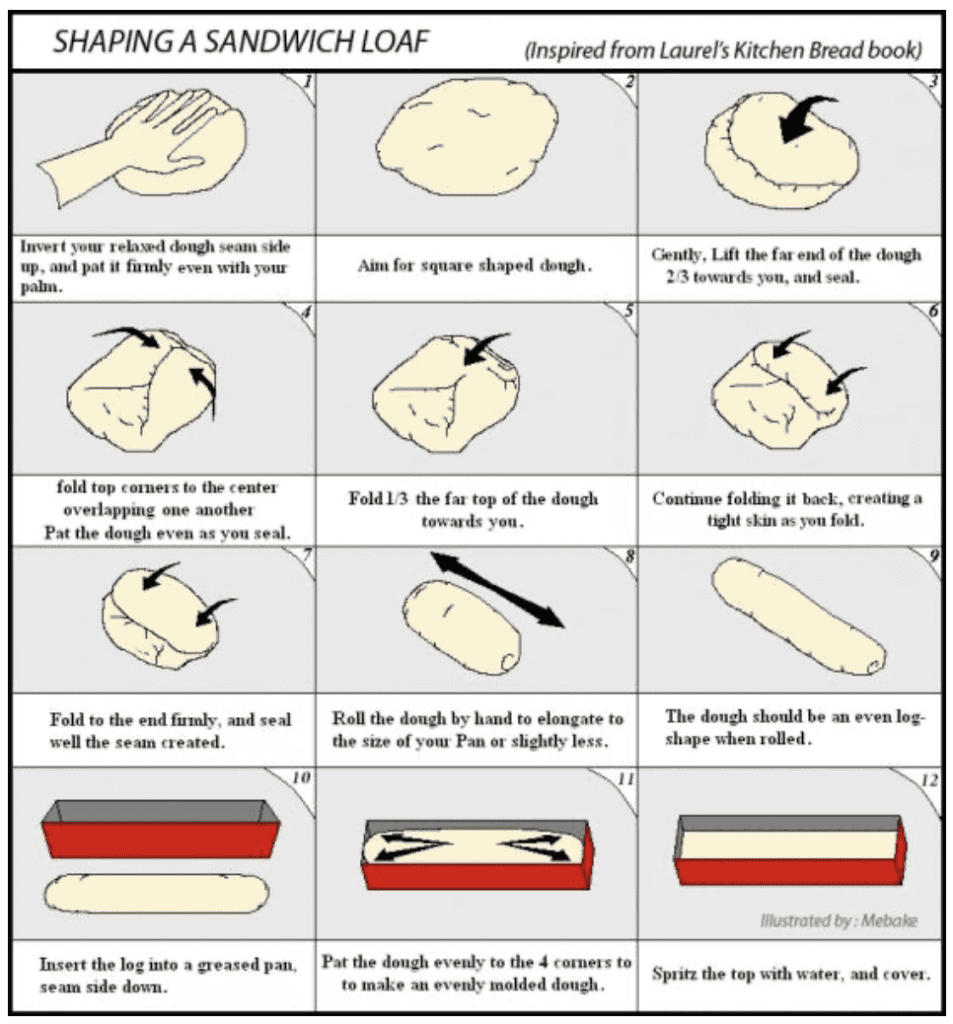
Then I let it do the rest of the fermentation and rise in this loaf pan that I have lined with parchment paper in my fridge, which will just slow it right down. It’ll still be fermenting, but at a slower pace than it is out here in my kitchen.
Score
For a long time, I did not score my breads and I still got good rises. So, I don’t know what all that’s about. Some people swear by it and you absolutely have to do it.
I would say experiment, see if it works better for you with or without. And then even when you do experiment, experiment a couple of times because you might think one time that it did work better, but it might have been because of something else. And so sourdough is lovely that way. We will always be experimenting, I feel. But this is a good work to be doing.
Bake
I really like the sandwich loaf pans. The edges of the tins give a little bit more structure to the dough and the loaf as opposed to the round ones from the Dutch oven. Especially with whole wheat since we’re already kind of at a disadvantage to get a really good rise because the bran is kind of sharp as it mills. I read that the bran in the wheat cuts some of those gluten structures, so the tin really helps and I can just create an environment where the moisture can help kind of bake the inside a little better.
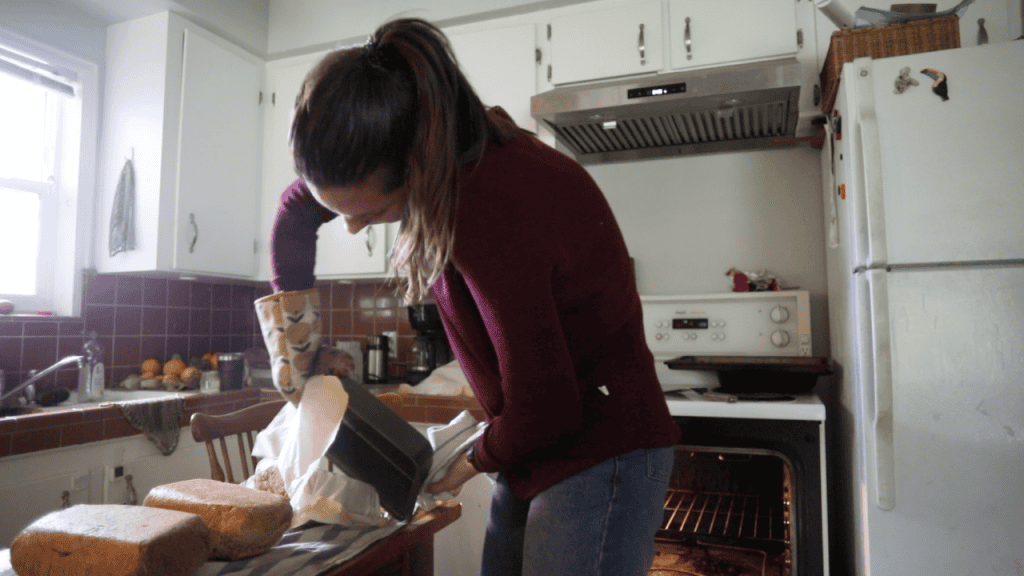
With the tins, I can also put bread pans on top to create an environment for the dough to cook more on the inside, although I got to say I haven’t really noticed that big of a difference if I don’t put the lids on. So maybe this is up for experimentation still and you can see what works best with or without. When I do put those tins on top, I only do it for 30 minutes and then take them off for the last 15 minutes.
Bake the loaves for 45 minutes at 475 F. Once the loaves are done baking, I take them out, remove them from the pan right away and kind of flip them on their side to help cool down the bottom of the loaf quickly.
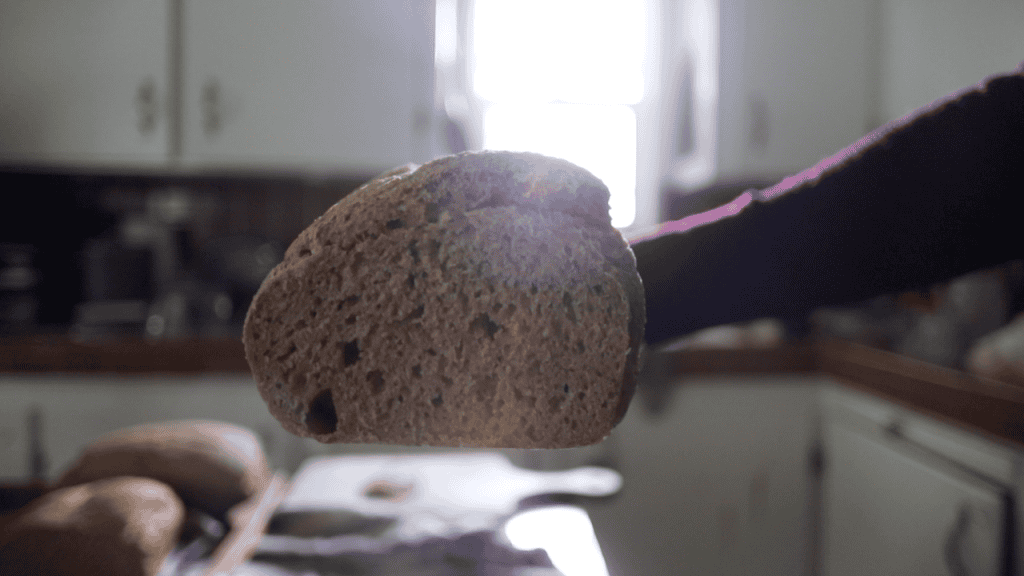
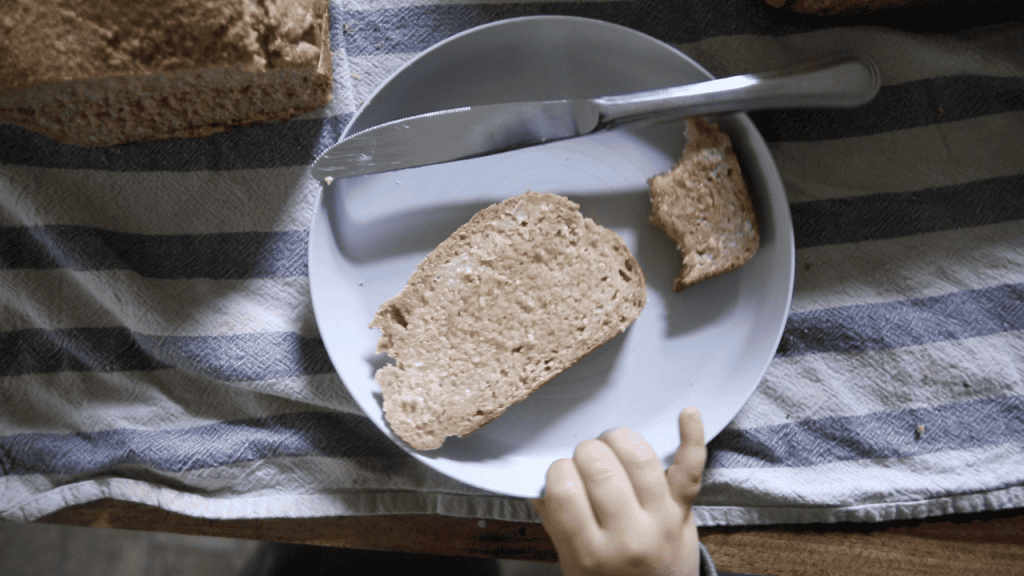
Watch How to Make Fresh Milled Sourdough Whole Wheat Bread
Here is a video where I show the steps to make these loaves!
Sourdough Recipe Whole Wheat (Fresh Milled)
Sourdough Recipe Whole Wheat Fresh Milled Flour
Equipment
- Mixing bowls
- Measuring scale
- Bench scraper
- Bread tins
Ingredients
To Feed Sourdough Starer
- 1 tbsp sourdough starter
- 1 cup flour
- 3/4 cup water
Bread Loaves
- 1000 ml Whole Wheat Flour freshly milled
- 400 ml Water room temperature
- 100 ml Sourdough Starter 75% hydration
- 10 ml Salt high quality makes a difference
Instructions
Feed Sourdough Starter
- Roughly 6-12 hours before you want to mix, scoop 1 tbsp of sourdough starter into a bowl
- Mix in 1 cup of flour and 3/4 cup of water
- Cover mixture and let it feed until it gets bubbly
Mix Dough/Fold
- Mill whole grains and have ready to mix.
- Measure flour and water into a bowl, mix and let it sit for 20-30 minutes to autolyse.
- Add sourdough starter and salt, then mix. Wait 5 minutes and mix again (it will be easier after a few minutes of waiting).
- Then leave the dough to ferment until its doubled in size (roughly 2-4 hours)
- During the fermentation time, apply 3-4 folds to the dough. Pull up on the side of the dough as high as you can without tearing the dough, then fold that piece over top of the dough. Do that all the way around the dough. This will help build the gluten structures and gas needed for the bread to rise in the final baking stage
Shape the Loaf
- When the dough has doubled, turn it out onto your counter slightly dusted with flour. The top will be on the bottom, and the bottom will now be the top
- Flatten the dough into a square format, then fold it according to the picture added to the recipe notes
- Add the rolled dough into a bread tin lined with parchment paper
- Cover with a tea towel and store in fridge for a few more hours to ferment (I do overnight)
Bake
- Preheat oven to 475 F
- Put bread into the oven to bake for 45 minutes
- After 45 minutes, remove from oven and from tins. Turn bread on their side to cool the bottoms well
Video
Notes
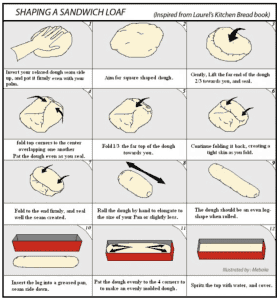
Is Fresh Milled Flour Healthier?
When is the last time you looked at the ingredient list on your white flour packages? I am just shocked that it’s taking away all the good stuff and then they’re adding and fortifying it with other vitamins and I just don’t see the point of that. Everybody should come to the whole wheat side and mill your grains fresh!
The real reason you want to be milling your grains fresh is because as soon as you mill it, all of these amino acids, oils, vitamins start to evaporate. You’ve got an about a 24-hour window to actually use it before it’s, you know, released a lot of that into the air and you’ve lost it. Some people say 48 hours. I’ve read other scientists say it should mix with water within 24 hours to really lock that in. Mill it fresh, use it right away – that’s the best answer.
Save This Sourdough Recipe Whole Wheat
I really believe that this is so important for all of us to get back to and I think it can bless you if you do do that. So may it go well. Please leave me feedback below if you do try try this recipe. I’m also still learning just like all of you. And so if you find some secret tips that really give you a better rise, I would love to know.

